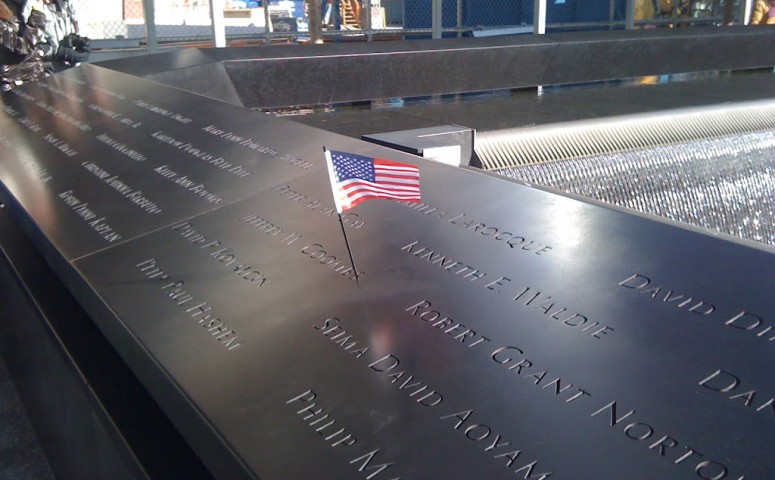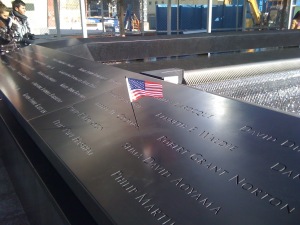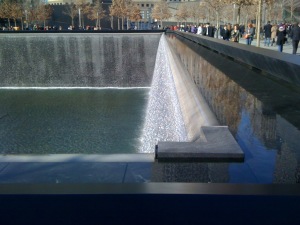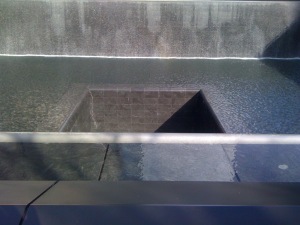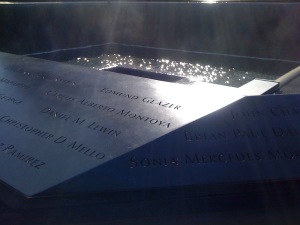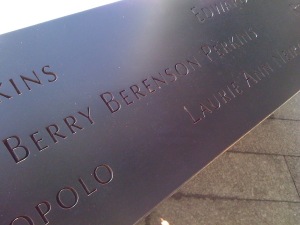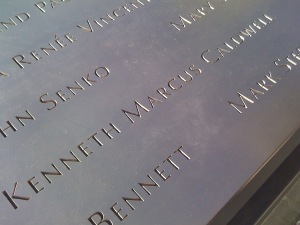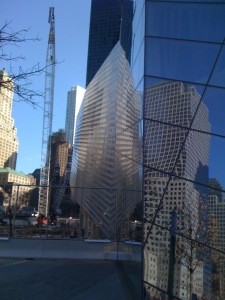The 9/11 Memorial
The 9/11 Memorial is incomplete. And that may be a good thing. No required video to watch, no precisely scripted experience. There is a long line even with a reserved ticket. In that way, it feels like a Disney park or a major historic tourist attraction. Security there is like a fast-paced version of a U.S. airport anywhere.
But once you’re inside the memorial, it is surprisingly barren on a winter day. The forlorn oaks still have a few dead brown leaves, and the surviving lawns are barely green. The memorial is a huge island-like plaza surrounded by buildings in various stages of completion. The construction noises are loud and at times hard to distinguish from the high level of city hum.
As you approach the two water-filled voids, the jackhammers, horns, bells, and sirens recede, and there is just the great sound of water falling. The voids occupy the spaces where the two World Trade Center Towers stood. Depending on the angle of the sun, the water dazzles or fades into a monochromatic sheet. As with Michael Heizer’s sculpture at Dia:Beacon, “North, East, South, West,” it is hard to see the bottom of the void. There is no end to sadness, to memory, to evil, to kindness. The metaphors can multiply and become intensely personal because of the abstraction the designers created.
Surrounding the voids are enormous bronze plaques with the names of the victims carved into each panel. Underneath the incisions lies darkness, although apparently, the names glow slightly at night. I was surprised by how large the letters are. I was worried that thousands and thousands of people would be lost in a litany of names. Where you look down, you can see an individual and think about his or her name and story. The names are organized according to the circumstances of their death, including Flights 11, 175, 77, 93; the first World Trade Center bombing on February 26, 1993; First Responders; World Trade Center North; World Trade Center South; and the Pentagon. Rather than arrange the names alphabetically, the victims’ families wanted them to be in proximity to friends or coworkers.
I was struck by the names of women followed by “and her unborn child.” In the corner of the north pool is the name of Berry Berenson Perkins, the wife of actor Anthony Perkins and sister of Marisa Berenson. Almost everybody takes photos, and some point to a name of someone they presumably knew. Couples hold up their iPhones at arm’s length to photograph themselves. The typical response is to smile, but then people stop themselves: is it OK to smile here?
As far as I’m aware, nobody I knew directly perished in any of these disasters. But I felt a need to recognize one person among the thousands. There are several helpful guides who can locate a name, and at computer stands, you can print out a map locating a name you have requested.
I entered my own name, Kenneth Caldwell. Kenneth (Marcus) Caldwell can be found on panel N-65. He was born in Philadelphia on February 8, 1971, lived in Brooklyn, and worked for a company called the Alliance Consulting Group. His survivors asked that his name be placed near that of Larry John Senko. I said a prayer for him.
The 9/11 Memorial is one place in the United States where design and faith come together without a predetermined narrative. The place lets each person contemplate an event that can never be understood. Right now it is about the water, the void, the names of those who died, and then all of us who are fortunate enough to be standing there looking for meaning, looking at each other.
For more information:
http://www.911memorial.org/
http://www.nytimes.com/library/national/met_MISSING_0925_caldwell.html
